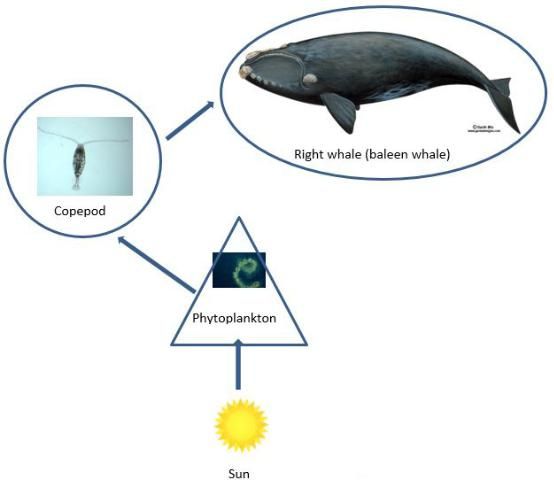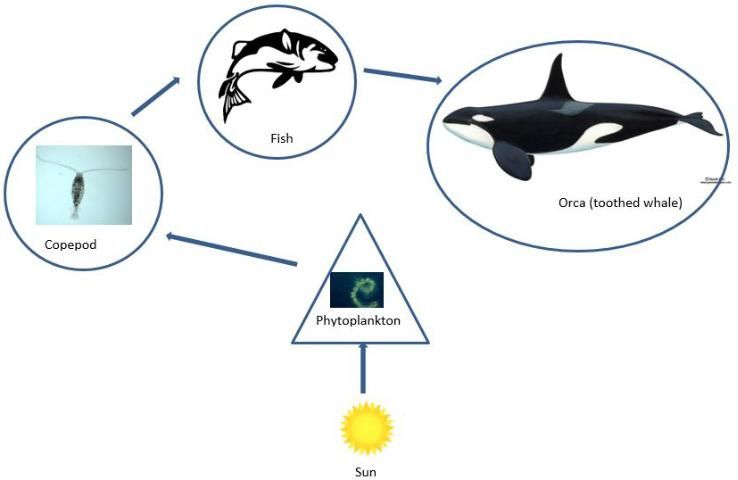Description
Students will identify components of baleen and toothed whale food chains and trace energy flow.
Objectives
By the conclusion of the activities, students will:
- Be able to explain how animals and plants interact in a food chain
- Be able to explain how "producers" (i.e., plants) get energy from the sun
- Be able to explain how "consumers" (i.e., animals) get energy by eating plants
- Be able to explain that some consumers are herbivores, meaning they only eat plants
- Be able to explain that some consumers are carnivores, meaning they eat other animals
- Be able to explain that some consumers are omnivores, meaning they eat plants and animals
- Be able to demonstrate (using a diagram) how energy moves through the food chain
What You Will Need
- Copy of Whale Food Chain Worksheets (pages 8-6 through 8-8) for each student
- Scissors for each student
- Glue sticks or clear tape
- Optional: Computer with Internet access and projector (or interactive whiteboard)
- Optional: Laptops or computers with Internet access for each student or small group
- Whiteboard and colored markers
Standards
Florida Sunshine State Standards
Science
-
SC.4.L.17.2 Explain that animals, including humans, cannot make their own food and that when animals eat plants or other animals, the energy stored in the food source is passed to them.
-
SC.4.L.17.3 Trace the flow of energy from the sun as it is transferred along the food chain through the producers to the consumers.
-
SC.4.L.17.4 Recognize ways plants and animals, including humans, can impact the environment.
Common Core Standards
Strategy
- (Optional) If you have access to SchoolTube, watch "Magic School Bus Gets Eaten" (Season 1: Episode 4) to introduce the concept of food chains. This can be accessed via https://www.schooltube.com/video/434b8b9aea014b058199/Magic%20school%20bus%20gets%20eaten (22 minutes).
- Explain to students that this lesson will focus on food chains. If you have previously introduced the concept of food chains, you may want to skip to step 12.
- Remind students that all living things depend on each other to survive. Explain that a food chain shows the relationships between plants and animals in an environment.
- In a food chain, there are two basic levels: producers and consumers. Remind students that plants are called producers because they can make their own food. Ask students if they remember where plants get the energy to make their own food [from the sun].
- Write the words SUN and PLANT on the board. Connect them with an arrow pointing from the sun to the plant [SUN --> PLANT]. Explain that the arrow shows which way the energy is flowing (i.e., from the sun to the plant).
- Write the word "producer" underneath PLANT on the board.
- Ask students to tell you the name of something that eats plants. Choose one of these answers and write it on the board, with an arrow pointing from PLANT to the animal (e.g., COW).
- Write the word "consumer" underneath COW. Explain that consumers cannot make their own food, so they have to get their energy from eating other things.
- Ask students if they can think of an animal that eats the animal you listed on your food chain. Using the example of cow, answers could include humans, lions, etc. Add this animal to the food chain.
- You should now have something that looks like this:

11. Explain to the students that you have just created a food chain. Ask them to remember what the arrows show [the flow of energy through the food chain]. Point out that there will always be a producer at the start or bottom of a food chain. Explain that consumers are animals, but that some consumers only eat plants, others eat only animals or meat, and others eat a combination of plants and animals.
12. Ask students if they can think of an animal that only eats plants. List correct answers on the side of the board. Explain that these animals are called herbivores. Many herbivores only have molars (grinding teeth) in their mouths. Some students may be familiar with the term vegetarian; if so, explain that vegetarian is a term used for humans who do not eat meat.
13. Ask students if they can think of an animal that only eats meat. List these animals on the board using a different marker. Explain that these animals are called carnivores.
14. Ask students if they can think of an animal that eats both plants and animals (humans would be an obvious example). Explain that animals that eat both plants and animals are called omnivores.
15. Give each student a copy of the Whale Food Chain Worksheet for baleen and toothed whales. Tell students that the organisms for the baleen whale food chain box are on the left side of page 8-7 and those for the toothed whale food chain are on the right side of that page. Review each of the organisms with the students (copepods are a type of zooplankton—animals that are part of the plankton—that eat phytoplankton; phytoplankton are tiny plants that float around in the water; fish eat copepods; right whales eat copepods; orcas eat fish).
16. Point out that students need to use ALL of the organisms when creating each of their food chains. Students should cut out each of the organisms and glue or tape the names into the appropriate box. Students will draw arrows to show the energy flow through the two food chains, so they should think about the energy flow before sticking their organisms onto the paper. Ask the students in which direction the arrows should point [from the thing giving the energy to the thing taking the energy, or from the thing being eaten (prey) to the thing doing the eating (predator)]. Instruct the students to draw a triangle around the producer and a circle around the consumers.
17. Once students have completed the activity, review the food chains with them. Ask the students to compare and contrast the two food chains. Select items in the food chain and ask the students where each one gets its energy. Ask what might happen to the toothed whale food chain if people created fishing nets that were able to catch many more fish than before. [If fish were removed from the food chain, toothed whales might starve, copepods would increase, and phytoplankton might decrease.] Might this have an effect on right whales? [More copepods could mean more food for right whales; that would lower the grazing pressure on the phytoplankton, so the phytoplankton wouldn't all get eaten.]
Whale Food Chain Worksheet
Baleen Whale Food Chain
Toothed Whale Food Chain
INSTRUCTIONS: Cut out these pictures and stick them onto the baleen whale food chain (pictures on the left) and toothed whale food chain (pictures on the right) worksheets to create food chains. Draw arrows to show the direction of energy flow in the food chains. Draw a TRIANGLE around the producer in each food chain. Draw a CIRCLE around each of the consumers in the food chains.

Credit: OpenClipart-Vectors from Pixabay (sun); NOAA (whale)

Credit: OpenClipart-Vectors from Pixabay (sun); OpenClipart-Vectors from Pixabay (fish); NOAA (whale)
Answer Key
Baleen Whale Food Chain

Toothed Whale Food Chain
